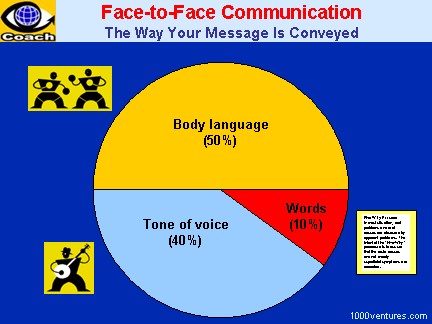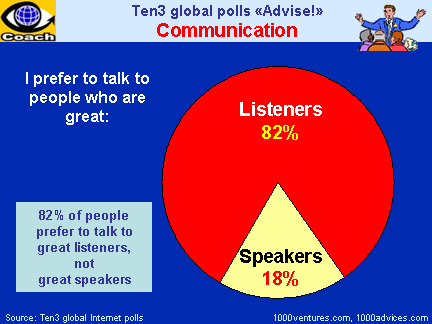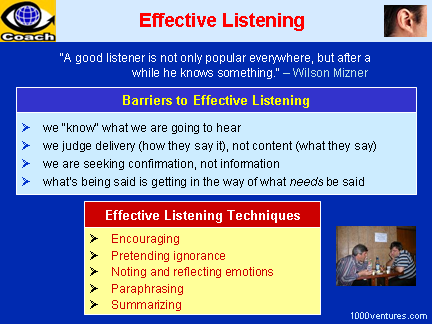
|
Language is More than Just Words2 |
|
Apart from words,
there are many other devices that also help
indicate and support meaning.
-
paralinguistic
features such as intonation, emphasis, volume and pace;
-
non-verbal
norms such as physical distance, touch and
eye contact;
-
cultural features, for
example ways of indicating agreement, of being polite.
|

|
 The Tao of Communication
The Tao of Communication |
-
Yin (Receiving):
Listening, understanding, being inspired...
-
Yang (Sending):
Speaking, persuading,
inspiring...
More
|

|
 Humorous Business Plan:
Great Communicator
Humorous Business Plan:
Great Communicator
Targeted Market:
"I like to talk with people who
express my thoughts clearly."
–
Unknown...
Communication Management Skills:
"Man is least himself when he talks in his own person. Give him a mask, and
he will tell you the truth."
–
Oscar Wilde...
Market Analysis:
"Some read to think, these are rare; some to write,
these are common; and some read to talk, and these form the great majority."
– Charles Caleb Colton...
More
 People Skills: 8 Humorous Quotes
People Skills: 8 Humorous Quotes
10 Great Communication Quotes
Know What Your Body Is Saying
"Body language accounts for more than half of
what other people respond to and make assumptions about when they connecting
with you. And more often than not, you're not consciously thinking about it.
By becoming conscious, you're 50 ahead of the game."3

Humorous Quotes
"A bore is a person who talks when you wish him to listen."
– Ambrose Bierce...
More
Yin and Yang of Communication
10 Rules of Effective
Listening
By: Linda Eve Diamond
Rule #1: Stop Talking!
You can't multi-task speaking and
listening. If you're talking, you're not
listening. This rule also applies to the talking inside your
head. If you're thinking intently about what you want to say,
you're not listening to what is being said...
More
The Tao of Effective Listening
Eye Contact
Eye is one of the most important nonverbal
channels you have for communication and connecting with other people. "The
cheapest, most effective way to connect with people is to look them into the
eye."1 Eyes are not only the "window to the soul", they also
answer the critical questions when you are trying to connect:
-
Is he paying attention to what I'm saying?
-
Does this person find me attractive?
-
Does this person like me?1...
More
Attitude Is Infectious and
Drives Behavior
Your
attitude is the first thing people pick up on in face-to-face
communication.1
Just as laughing, yawning, and crying are infectious, attitude is infectious.
Before you say a word, your attitudes can infect
the people who see you with the same behavior. Somehow just by looking or
feeling, you can be infected by another person's attitude, and vice versa.
When you are operating from inside a really useful
attitude, such as enthusiasm, curiosity, and humility, your
body language tends to take care of itself and sends out unmistakable
signals of openness...
More
Pretending Ignorance: Smart Is
Dumb
Socrates used this technique more than 2300 years ago. He
pretended ignorance in order to encourage others to express their views
fully.
Today, many world's smartest and fastest businesspeople have perfected this art
– consciously or unconsciously – of paying dumb. "People who try to impress by
pretending to be smart generally aren't. Truly smart people know that by playing
dumb and asking the other party to repeat or explain things several times,
asking
lots of questions, they'll be better prepared to respond and then make a
fast decision." 3
Socratic Questions
Socratic questioning is at the heart of critical thinking – they
enhance your critical thinking skills.
Socratic questions challenge accuracy and completeness of
thinking in a way that acts to move people towards their
ultimate goal...
More
Become an Irresistible
Sales Communicator
Despite what most books and seminars teach,
successful selling
is not a set of strategies, techniques or tactics to get the prospect to
buy.
Rather it is a state of
mind
–
yours and your customer's
– and set of behaviors that creates
compelling win/win outcomes for everyone...
More
Move From HOW Are You To WHO Are You
6 Creative Questions
By: Scott Ginsberg
There comes a time in every conversation with someone you’ve
just met when you must cross the chasm between “HOW are you?”
and “WHO are you?” A helpful technique for doing so is by
asking creative, open ended questions. These questions
function as front porches, inasmuch as their ability to
build rapport, spark creativity and invite people to share
their experiences and preferences. What’s more, they show an
interest in people’s opinions and insights...
More
|